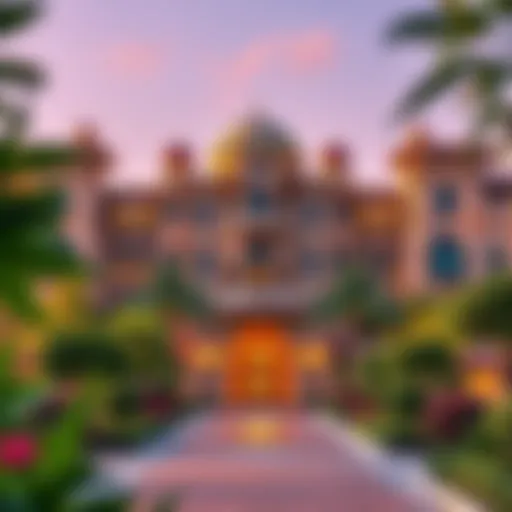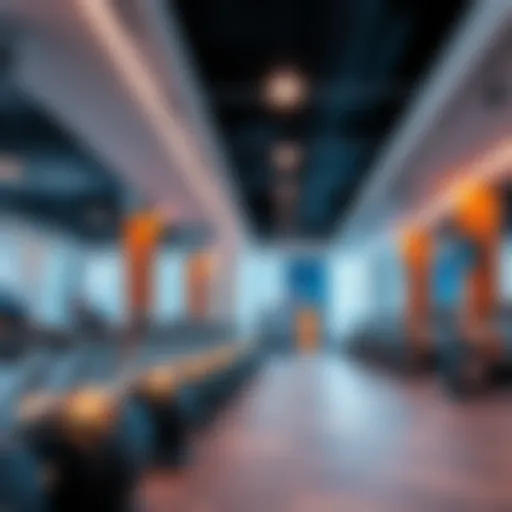Discovering the Lootah Building: A Dubai Icon
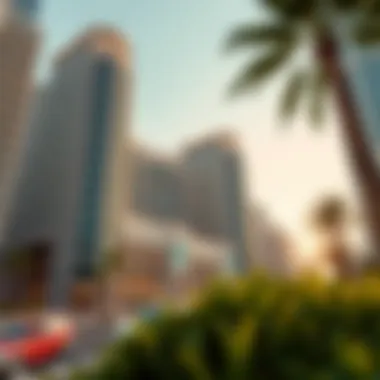

Intro
The Lootah Building captures a unique essence of Dubai's skyline, intertwining modern architectural practices with traditional cultural influences. As you enter its vicinity, the structure commands attention, not just for its height and design but also for what it represents in the ever-evolving narrative of Dubai. Positioned in a bustling neighborhood, the building is both an architectural expression and a landmark that reveals the dynamics of growth in this remarkable city.
This article will journey through the intricacies of the Lootah Building, showcasing its historical roots, architectural design, and the cultural milieu that surrounds it. By understanding the Lootah Building, readers will appreciate its contribution not only to the architectural landscape of Dubai but also to the lives of those who inhabit or visit the area.
After exploring the building itself, we will delve into the broader aspects of its location, examining neighborhood characteristics and cost of living to better understand the context in which this structure exists. Moving forward, we'll also unveil the lifestyle insights that enrich life within these walls, including cultural activities and local dining experiences. Ultimately, it’s about connecting the dots—how does an iconic building shape the lives of expatriates, tourists, and locals alike?
Prepare to engage with the rich commentary on how the Lootah Building stands as a testament to the resilience and ambition that defines Dubai.
Prolusion to the Lootah Building
The Lootah Building is not just another structure in the bustling city of Dubai; it represents a confluence of history, culture, and architectural ambition. As the city has rapidly evolved from humble beginnings to a global hub, the Lootah Building stands as a testament to this transformation. Understanding its significance helps convey the essence of Dubai's architectural evolution and urban identity.
A Brief Overview
Nestled within the heart of Dubai, the Lootah Building showcases a blend of modernity and tradition. Constructed in the late 20th century, its design reflects both the local cultural heritage and the international influences that have shaped the emirate. This distinctive building not only boasts impressive architectural features but is also recognized for its contributions to the local skyline. From its strategic location to its innovative design elements, the Lootah Building serves multiple roles—residential, commercial, and cultural.
This gem is not merely a structure; it’s a reflection of a growing city embracing its past while looking toward the future. Local residents, expatriates, and tourists alike can find a myriad of reasons to appreciate the Lootah Building, making it a landmark in the ongoing narrative of Dubai’s architectural landscape.
Significance in Dubai's Architecture
The importance of the Lootah Building extends beyond its exterior aesthetics. It embodies the aspirations of a rapidly urbanizing Dubai, often described as a canvas where different architectural styles coexist. The building captures the spirit of innovation by incorporating sustainable practices within its design philosophy, setting a precedent for future developments.
Moreover, the Lootah Building serves as a cultural touchstone. It offers a glimpse into how modern architecture can harmoniously coexist with traditional values. For instance, its facade may exhibit patterns inspired by local artistry and crafts, while embracing modern materials and techniques.
"The Lootah Building is more than a prominent feature of the skyline; it is a narrative of continuity and change in the emirate's architectural heritage."
As Dubai's skyline continues to evolve, understanding the Lootah Building and its role highlights the intricate relationship between the city’s past, present, and future. It stands formidable against the backdrop of skyscrapers, while also reminding us of local history, making it essential for anyone wanting to delve into the architectural tapestry of Dubai.
Historical Context
The Lootah Building's historical context reveals a tapestry of architectural and cultural narratives that define its significance in Dubai. Understanding this backdrop is key for grasping the evolution of the city's landscape, which has undergone a radical transformation over the past few decades. The building stands not just as a structure, but as a witness to the socio-economic changes and urban development that Dubai has experienced.
The historical importance can be encapsulated in a few essential aspects:
- Chronological Development: Examining the timeline of the building's construction illuminates its place within the transition from a modest coastal city to a bustling metropolis. Understanding when and why it was built sheds light on the architectural trends of the period.
- Influence of Cultural Heritage: The Lootah Building is more than concrete and steel; it echoes the history and traditions of the UAE. Its design elements often reflect the cultural values and aesthetics of the time, making it an important artifact for both locals and visitors.
- Visionaries Behind the Project: Knowing who initiated the building project can provide context to its significance. Key figures, from architects to investors, have played crucial roles in shaping how the structure was designed and where it fit within Dubai's burgeoning economy.
Construction Timeline
The construction timeline of the Lootah Building serves as a marker of Dubai's rapid development. Completed in the late 1990s, the project was part of a larger trend of skyscrapers that began to populate the Dubai skyline. Initially conceptualized in the early 1990s, the vision for this landmark was born out of a need for diverse commercial spaces. The construction period faced challenges typical for the region, including the harsh climate, which necessitated specific engineering solutions to ensure durability and energy efficiency.
- Significant milestones in the timeline include:
- 1992: Initial designs and planning.
- 1995: Groundbreaking ceremony, igniting hopes for a new architectural icon.
- 1999: Completion and official opening, coinciding with the city’s distinctive architectural identity.
This timeline not only signifies architectural progress but also reflects the greater story of Dubai's transformation from a trading port to a global hub.
Key Figures and Stakeholders
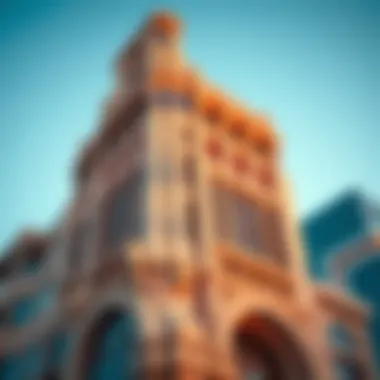

Every significant building has its influencers and stakeholders, and the Lootah Building is no exception. It was conceived by a group of visionaries whose ambitions shaped its concept and brought it to life. Among these key figures were:
- Shaikh Mohammed bin Rashid Al Maktoum: As the driving force behind many of Dubai's architectural advancements, his vision for modernity and growth played a critical role.
- Architects and Engineers: A diverse team, including both local talents and international experts, contributed design philosophies that blended traditional elements with contemporary architecture.
- Investors and Developers: Private investors took a calculated risk during a formative time in Dubai's real estate market, hoping to capitalize on the burgeoning economy that promised high returns.
"In Dubai, you don’t just build buildings, you sculpt elements of history that will speak to future generations."
These figures not only laid the groundwork for the building itself but also contributed to the cultural and economic tapestry of Dubai, intertwining their fates with a structure that has become emblematic of the city’s growth.
Understanding this historical context offers rich insights into how architectural landmarks, like the Lootah Building, play a pivotal role in narrating the story of a city on the rise.
Architectural Features
The architectural features of the Lootah Building stand out as a testament to the intersection of tradition and modernism that shape Dubai's skyline. The design elements not only showcase aesthetic appeal but also serve functional purposes, which is crucial in a city that thrives on its fast-paced development and tourist influx.
Design Principles
At the core of the Lootah Building's design is an adherence to principles that echo the cultural heritage of the UAE while embracing contemporary architectural trends. One significant aspect is the use of symmetry. The building's layout and façade feature symmetrical patterns that create a sense of balance and harmony, reflecting the values of the local culture. This symmetry is not just for visual appeal; it also optimizes space and light distribution within the building, enhancing the overall experience for visitors.
Natural ventilation is another principle that has been skilfully integrated. Given the arid climate of Dubai, harnessing airflow is smart. Large openings, shaded verandas, and perforated walls promote airflow, allowing the building to remain cool without heavy reliance on air conditioning. This design consideration reflects both sustainability and an understanding of local conditions.
The geometric patterns found throughout the building’s exterior speak volumes about traditional Islamic art, yet the application is modern. These motifs draw visitors in while hinting at a deeper story behind the architectural choices — a blend of old and new that resonates deeply in a rapidly evolving urban landscape.
"The Lootah Building exemplifies how modern architecture can pay homage to cultural roots without compromising functionality."
Materials and Techniques
When examining the materials and techniques employed in the construction of the Lootah Building, one sees an intricate selection that balances durability with aesthetics. The dominant material used is reinforced concrete, which provides the structural integrity necessary to withstand the elements and the weight of the building itself. This choice is typical for modern structures but is juxtaposed with more traditional elements, such as local stone, which decoratively clads sections of the building.
Incorporating glass in the design allows the structure to reflect the sunlight, creating beautiful plays of light and shadow throughout the day. The glass facade not only gives the building a contemporary feel but also maximizes natural light inside, improving the internal ambiance.
Furthermore, sustainable construction techniques were employed. The use of solar panels integrated into the building’s design exemplifies forward-thinking urban development, while rainwater harvesting systems are another boon, promoting water conservation. Each element — from the choice of materials to sustainable practices — is a thoughtful nod towards a more eco-friendly future without sacrificing style.
Cultural Significance
The Lootah Building is more than just a structure; it's a notable representation of Dubai’s identity that intertwines its rich past with its aspirations for the future. The architectural design serves as a window through which we can see the cultural narrative of the region, reflecting both tradition and modernity. Understanding the cultural significance of this building provides insights into its role in shaping local identity and influencing community interactions.
Reflection of Local Identity
At the heart of the architectural narrative is how the Lootah Building embodies local identity. Its design elements echo the spirit of Dubai’s heritage while also embracing contemporary influences. The thoughtful incorporation of traditional motifs into the structure's modern facade highlights a dialogue between past and present. This fusion is not accidental; it symbolizes the journey of a city that has transformed remarkably over just a few decades.
The use of local materials and craftsmanship is evident in the building’s architecture, showcasing the skills of artisans who have honed their crafts through generations. The integration of cultural elements provides residents and visitors with a sense of belonging. It tells a story that resonates with those familiar with the city’s history, allowing them to connect emotionally with their surroundings.
Moreover, the building acts as a hub for community events, reinforcing its role in the social fabric of Dubai. Public art installations around the site often celebrate local culture, making it a vibrant place for gatherings, discussions, and exhibits that resonate with both locals and expatriates alike.
Impact on Community and Society
The impact of the Lootah Building goes beyond its walls. It stands as a testament to the development of community ties in a rapidly changing landscape. The building has contributed significantly to urban life, serving as a focal point around which activities and interactions unfold. This layered role enhances the sense of togetherness in a city known for its diversity.
In recent years, as the city grapples with issues of identity amidst globalization, the Lootah Building has become an emblem of resilience. Local communities utilize its spaces for workshops, art fairs, and even cultural celebrations, thus fostering a sense of ownership and responsibility toward their heritage.
Additionally, the building's presence has stimulated economic value for the surrounding area. Businesses have flourished nearby, catering to visitors and local patrons who converge in the area. This ripple effect leads to job opportunities and enhances the economic landscape, ultimately uplifting the community.


"The Lootah Building is more than bricks and mortar; it is the heart of a thriving community, intertwining local identity with modern aspirations."
In essence, the cultural significance of the Lootah Building remains deeply rooted in how it reflects local identity and influences social interactions, carrying forward the traditions while forging ahead into the future.
The Lootah Building in Contemporary Dubai
The Lootah Building holds a pivotal place in the narrative of Dubai's ongoing architectural transformation. In the realm of real estate development, it is more than just bricks and mortar; it embodies the spirit of innovation that is synonymous with Dubai's growth. As the skyline continues to evolve, understanding the influence of the Lootah Building is essential for expats and locals alike, especially those involved in real estate and urban planning.
Role in Real Estate Development
The Lootah Building is often hailed as a prime example of how historical and modern elements can coexist in a rapidly changing urban landscape. Its establishment heralded a new era in real estate developments in Dubai. Property developers frequently draw inspiration from its unique fusion of contemporary design and cultural elements.
- Architectural Influence: With its distinctive facade and thoughtful architectural style, the Lootah Building has set a benchmark for many projects that followed. It serves to remind us that buildings can be more than functional; they can reflect stories and heritage.
- Real Estate Performance: Properties surrounding the Lootah Building have seen significant appreciation in value. Its presence enriches the surrounding area, making it more desirable for both residential and commercial investments.
- Community Hub: At its core, this building helps foster a sense of community. It has become a central meeting point for various cultural initiatives, drawing residents and tourists alike.
The importance of the Lootah Building transcends mere aesthetics or financial value; it is woven into the fabric of Dubai’s real estate sector, reflecting the dynamic interplay between history and modernity.
Integration with Urban Planning
In terms of urban planning, the Lootah Building symbolizes a careful balancing act between the preservation of local culture and the demand for modern infrastructure. It plays a crucial role in Dubai’s strategy to create a livable, attractive urban environment.
- Strategic Location: Situated in a vital area, the building acts as a keystone in mitigating urban sprawl. Its position encourages compact urban development, which is both sustainable and economically sensible.
- Sustainable Practices: The Lootah Building integrates eco-friendly materials and energy-efficient systems. This focus on sustainability is increasingly important in urban planning discussions, providing a model for future developments.
- Cultural Connectivity: By aligning with existing landmarks and community spaces, it enhances the overall urban ecosystem. This connection is critical for maintaining a sense of place in an ever-expanding city.
"The Lootah Building exemplifies how architectural intent can shape not only the skyline but also the urban experience of a city, ensuring that progress doesn't come at the cost of losing identity."
Through these dimensions, the Lootah Building stands as a significant landmark in Dubai's architectural landscape, influencing both real estate trends and urban development strategies. For those invested in or new to the dynamic city of Dubai, understanding the role of iconic structures like the Lootah Building is indispensable.
Challenges and Criticisms
The Lootah Building, while celebrated for its architectural significance and cultural symbolism, isn't without its share of challenges and criticisms. Addressing these aspects is crucial for a comprehensive understanding of how this structure fits within the evolving context of Dubai’s urban landscape. Evaluating issues around historical preservation and contemporary urban pressures sheds light on the delicate balance between development and heritage.
Historical Preservation Issues
Historical preservation is a key concern when discussing the Lootah Building. As Dubai rapidly modernizes, many structures face the threat of being overshadowed or eliminated entirely in pursuit of new developments. In this whirlwind of progress, the Lootah Building stands as a remnant of the past, emphasizing the need for thoughtful preservation measures.
One of the pressing issues here is the debate surrounding the building’s original architecture versus the contemporary adaptations that have been made. When modernization occurs, there may be a tendency to overlook or even erase the historical elements that contribute to the building's character. Matters of authenticity arise, as some argue that changes detract from what makes the Lootah Building significant. The challenge lies in maintaining its historical integrity while ensuring that it remains functional and relevant in today’s context.
The discussion about preserving such a landmark also involves community engagement. Local voices often advocate for preserving the identity of neighborhoods, and the Lootah Building plays a pivotal role in this narrative. Engaging local residents in the preservation discourse can foster a sense of ownership, ensuring that alterations consider the sentiment of those who are most affected. However, this is not always straightforward. Conflicts can arise between developers, preservationists, and the community, leading to a complicated dynamic that influences future decisions.
Contemporary Urban Pressures
In parallel to historical preservation, contemporary urban pressures represent another layer of challenge for the Lootah Building. The rapid pace of urban development in Dubai creates a backdrop of competitive real estate dynamics. Developers often face mounting pressure to maximize land use, which may prioritize short-term gains over long-term sustainability. As a result, the Lootah Building finds itself at a crossroads between preserving its legacy and accommodating the relentless march of urbanization.
Moreover, the influx of expatriates and tourists has led to increased demand for modern amenities and infrastructure in this real estate hub. While investment in urban growth is essential, it can sometimes clash with the core essence of existing structures. As developers and urban planners navigate these pressures, the challenge becomes finding a balance that respects the historical significance of places like the Lootah Building, while integrating them into the contemporary urban fabric.
Decisions around development zoning, local regulations, and the implications of increased foot traffic all play into the continuing narrative of the Lootah Building. Community feedback is vital in this aspect as stakeholders come together to negotiate what comes next for this landmark. It is essential to consider not only economic implications but also the potential social impacts on those living and working in its shadows.
The debate around historical preservation and contemporary urban pressures invites reflection on what it means to protect a city’s legacy while simultaneously moving it forward. The questions are challenging, and solutions are often complex. Yet, addressing these challenges is not just about maintaining the Lootah Building; it’s about shaping the future of Dubai as we continue to navigate between the old and the new.
Future Prospects
The future of the Lootah Building is not just about bricks and mortar; it involves envisioning how this iconic landmark can continue to shape and be shaped by the cultural and urban fabric of Dubai. As the city rapidly progresses, so too must its architectural heritage. This section delves into the horizon ahead, exploring future developments and potential transformations that can breathe new life into this remarkable structure.
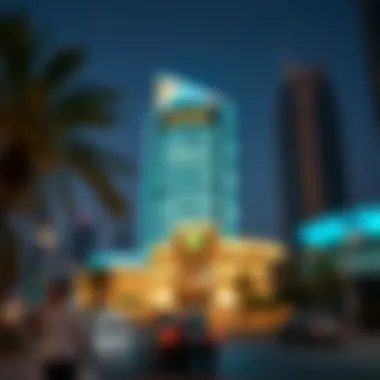

Future Developments
The Lootah Building is set to see a range of developments in the coming years. These aren't merely cosmetic updates; they entail engaging with the very essence of what the building represents in today’s context. Here are some key aspects to look forward to:
- Technological Integration: Smart technology is likely to play a major role in boosting the building's functionality. This could mean integrating energy-efficient systems that align with the global push towards sustainability.
- Cultural Programs: One significant area for upcoming development is cultural programming. With narratives steeped in local history, the building could host exhibitions, art shows, and community events.
- Collaboration with Real Estate: Future developments may see partnerships with real estate firms to open up new retail or leisure spaces within the structure itself.
These elements combined can maximize the building's presence and relevance, drawing both tourists and locals alike, as well as enhancing its aesthetic appeal within the urban landscape.
Potential Transformations
As for transformations, the Lootah Building could evolve in several remarkable ways, potentially redefining how it interacts with its environment and the people who inhabit it. Consider the following possibilities:
- Adaptive Reuse: This concept is not new in urban planning, yet its application in the Lootah Building could create opportunities to repurpose existing spaces without extensive new construction. This might involve creating co-working spaces or cultural hubs that resonate with contemporary needs.
- Environmental Sustainability: The transformation of the building might also lean heavily into environmentally friendly practices, which not only preserve the structure but also elevate the building's role in Dubai's commitment to honor its ecological footprint.
- Design Innovations: Future renovations may involve creative redesigns of both interior and exterior elements. This kind of innovation can enhance the building's visibility—morphing it into a beacon that showcases modern architectural artistry while respecting its historical roots.
As Dubai continues to reinvent itself, integrating these developmental and transformational aspects will serve to establish the Lootah Building not just as a nostalgic reminder of times past, but as a dynamic entity that adapts and thrives within its community.
In contemplating the future of the Lootah Building, local residents, expatriates, and potential investors can truly see a landmark that encapsulates more than just its foundation; it stands as a living entity that beckons ongoing dialogue and exploration, maintaining its status as a pivotal part of Dubai's architectural landscape.
Visiting the Lootah Building
Visiting the Lootah Building is a rich experience that goes beyond mere sight-seeing. This structure isn't just a cool place to snap a selfie; it's a conversation starter about the intricate layers of Dubai's architectural identity, reflecting cultural nuances while being a functional space. Whether you're an expatriate, a tourist, or a local, understanding this landmark adds depth to your perspective of Dubai’s fast-paced urban evolution.
Accessibility and Location
Situated prominently in Al Quoz, a neighborhood known for its eclectic mix of art studios and commercial spaces, the Lootah Building is easy to spot. Its location is strategic, bridging residential developments and commercial districts, which makes it a prime spot for both visiting professionals and curious tourists.
Transport options abound here:
- Metro: The nearest station is a quick 15-minute ride away, connecting visitors to other parts of the city.
- Bus Services: A reliable network of buses operates close by, making it convenient for those relying on public transport.
- Personal Vehicles: Ample parking space is available, easing the jitters for those driving in.
The building itself is like a focal point amidst the hustle, welcoming guests with its distinct modern architecture. Even if you're just passing by, the Lootah Building’s form can’t go unnoticed; it stands proud among traditional and contemporary structures, a true representation of Dubai's dynamic spirit.
Nearby Attractions
Once you've marveled at the Lootah Building, the surrounding area has more to offer. Here are some nearby attractions worth exploring:
- Alserkal Avenue: This cultural hub is a stone's throw away, filled with art galleries and creative spaces that speak to the emerging local art scene.
- Dubai Autodrome: A must for motorsport enthusiasts, offering thrilling car races and driving experiences.
- The Green Planet: An indoor rainforest that houses exotic wildlife, perfect for those wanting a unique nature experience amidst the urban sprawl.
- City Walk: A stylish outdoor shopping and dining destination featuring international brands and gourmet options, great for a leisurely stroll after visiting the building.
- Zabeel Park: A beautifully designed park not too far from the Lootah Building; it's an excellent place for a picnic or a leisurely walk.
In visiting the Lootah Building, you’re not only engaging with a significant piece of architecture but also opening the door to a variety of experiences that enrich your understanding of Dubai's urban tapestry. As you plan your visit, keep these perks in mind.
The End
The Lootah Building is much more than just a structure among the glittering skyline of Dubai. Its significance unfolds through layers of history, architecture, and culture, ultimately contributing to the very essence of what Dubai represents today. As the curtain falls on this exploration, it's important to recognize the multifaceted role this landmark plays within its vibrant urban tapestry.
Summary of Insights
In summary, the Lootah Building stands as a critical piece in the puzzle of Dubai's architectural narrative. Its innovative design principles, combined with the careful selection of materials, mirror the region's commitment to merging tradition with modernity. The building ensures that the local identity is not lost amid rapid urbanization. The cultural reflections evident in its prominence argue for a balance between preserving history and accommodating growth. Visitors and residents alike can appreciate how it serves as a bridge between the past and present, emphasizing the need to retain heritage while embracing forward-thinking developments in urban planning and design.
It's essential to consider that the challenges faced by the Lootah Building are indicative of broader issues within Dubai. From historical preservation to responding to ever-increasing urban pressures, the journey of this building offers lessons not just for architects and developers but for everyone invested in the future of urban life. The insights gleaned here can inform better planning decisions that honor the past while paving the way for a sustainable, enriching urban environment.
Final Thoughts
In closing, the Lootah Building is more than a mere attraction — it symbolizes the dynamism of Dubai’s evolving architectural landscape. As we look ahead, it will be fascinating to observe how this landmark continues to adapt and function within a city that often pushes boundaries.
Visitors, residents, and stakeholders should keep an eye on initiatives targeting community development and preservation. By focusing on sustainability and a deep respect for local identity, the journey of the Lootah Building can inspire future projects in Dubai and beyond. It serves as a reminder that true architectural significance lies not only in aesthetics but also in the stories and values it encapsulates.
As new generations of architectural minds and urban planners step onto the scene, the lessons from landmarks like the Lootah Building will serve as guiding lights. They remind us all that every brick laid and every design chosen should contribute to a larger narrative — one where heritage and modernity coalesce harmoniously.



